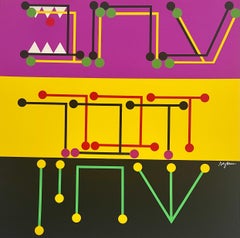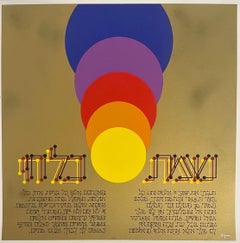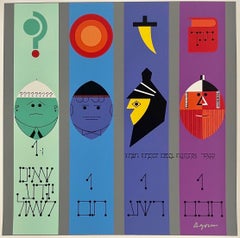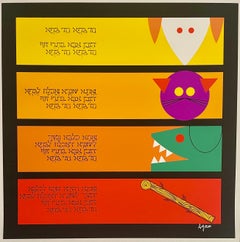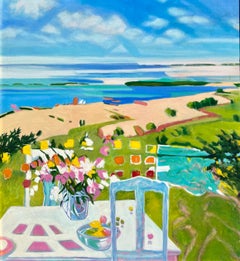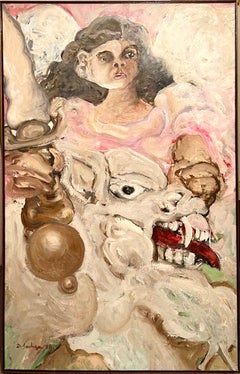Diego Barboza - 1945-2003
Hand signed and dated 1988 Oil on Canvas
Diego Barboza was born the Carabobo street of Maracaibo, Venezuela on February 4, 1945. He was a Venezuelan Neo Figurative Painter who is among the most famous and influential figures in Venezuelan art history. Diego Barboza opened a new chapter in Latin America, beyond the surreal or the magical realism of the Modern Latin American Masters. He created a new language of dislocation and transgression. Personages became distorted to the point that was very exaggerated forms His figures twisted and contorted without losing their presence or their pull. Extremities muscles, and bones burst into an explosive compound of divergent and convergent lines. Through eruptive brushstrokes and fractured outlines. Barboza created a world of illusions.
Barboza was born into a upper-middle-class family. He stopped going to school at 12 years old, and he registered himself at the School of Visual Art in the City of Maracaibo Venezuela. Barboza studied at the School of Visual Arts in Caracas, Venezuela. Barboza began his training as an artist at age 12 in his native Maracaibo when he left formal education to enroll in the then School of Plastic Arts of Zulia, then Julio Arraga School of Plastic Arts, where he was a student in the modeling, collage and Drawing of Angelina Curiel. His first collages, in the sixties, show the influence of American Pop Art. In 1967 he exhibited at the Ateneo de Caracas his series 'Los Ratones', a proposal then 'criticized by critics as unprecedented in Venezuela'. In his tribute to the film "Nosferatu" Friedrich Murnau included 32 drawings as well as two-dimensional objects. In 1968 he moved to London where he studied at the London College of Printing. From that time is his '30 Girls with Nets', an action in which 30 students of the London College of Printing, dressed in black and covered by white nets, toured London public places, behaving naturally. His 'street expressions', which he later called 'poetic actions', symbolized a breakdown of social restraints through unusual behaviors that sought to provoke public reactions. Upon his return to Venezuela in 1973, Barboza continues with this line of work, being recognized as one of the initiators of Venezuelan conceptual art. In the 1980's Diego Barboza turned to painting, the New Venezuelan Figuration. Here belongings and the feminine figure fill the work of that time, in which he embodied his intimacy and daily life through scenes of furnishings and flowers that included objects from his workshop and home. His nudes were made from live model, then to follow the path of distortion resulting in their unmistakable females: a figure that represented their personal way of appreciating beauty. Barboza presented his first individual exhibition at the Centro de Bellas Artes of Maracaibo Venezuela. In 1963, he traveled to London when the Conceptual Art movement started, he had the support of the London New Art Lab Gallery. On March 7, 1970 Barboza displayed his first work on Conceptual Art, which he called Art of Action. In London with the performance of 30 Girls with nets (30 Muchachas con redes). His second work was Nets and Hats in markets and restaurants (Con sombreros y redes en mercados y restaurantes). In London UK. His third The Centerpiece (El Ciempies) and the fourth Expression on a laundry-mat (Expresiones en una lavandería)
In 1974. Baboza returned to Venezuela. Where he presented two very important Conceptual Art works: The Armadillo Box (La Caja del Cachicamo) and from the School of Athens to the New School of Caracas (De la Escuela de Atenas a la Nueva Escuela de Caracas). Closing his cycle of Conceptual Art creation. IN Venezuela a sort of impromptu academy started up at Claudio Perna’s house. Eugenio Espinoza, Roberto Obregón, Antonieta Sosa, Alfred Wenemoser, Yeni and Nan, Sigfredo Chacón, Diego Barboza, Luis Villamizar, Margherita D’Amico, Pedro Terán, Alfredo del Mónaco, as well as international figures who happened to be visiting Venezuela such as Antoni Muntadas, Charlotte Moorman, and Roman Polanski would gather there. Venezuela, especially Caracas, was a rich field of action for modernism in South America. Venezuelan Geometric Abstraction, Op art and Kinetic Art dominated through crucial figures like Jesús Rafael Soto, Gego, Alejandro Otero, and Carlos Cruz Diez, the country’s kinetic art made a fundamental contribution internationally. The Greater London Arts Association and the Arts Council of Great Britain did several exhibitions of (North, Central, South, London, Wales, Scotland and Ulster) to show the actual Visual Arts in all of the United Kingdom and Diego Barboza was invited for this event with a solo exhibition, expressions around a cylinder (Expresiones alrededor de un cilindro).
Diego has made numerous solo and group exhibitions, obtaining rewards since 1963. He is represented in the most important museums of Venezuela, as well as in England, Brazil, Colombia and Cuba. In 1986 he was awarded the Municipal Visual Arts Award of the Municipal Council of the Federal District and in 1997 he received the National Prize for Plastic Arts granted by the National Council of Culture, CONAC.
Select Group Exhibitions
1964 Ateneo de Caracas, Caracas, Venezuela
1965 Salón Arturo Michelena, Valencia, Venezuela
1968 Salón Oficial Museo de Bellas Artes, Caracas, Venezuela
1971 Art Spectrum London, London, Great Britain
1972 Serpentine Gallery, London, Great Britain
1973 Midland Group Gallery, London, Great Britain
1974 Galería BANAP, Caracas, Venezuela
1975 Casa de Las Américas, La Habana, Cuba
Museo de Bellas Artes, Caracas
Galería de Arte Nuevo, Buenos Aires, Argentina
1976 Museo de Arte Moderno, Bogotá, Colombia
Museo de Arte Contemporáneo, Sao Paulo, Brazil
Museo de la Tertulia, Cali, Colombia
Bienal de Venecia, Venecia, Italy
1979 Centro de Artes y Comunicación, Buenos Aires, Argentina
1980 Galería NBC, Memphis, Tennessee, USA
1981 Galería de Arte Nacional, Caracas, Venezuela
Museo de Arte Contemporáneo, Medellín, Colombia
Museo de Bellas Artes, Caracas, Venezuela
1986 Museo de Arte La Rinconada, Caracas, Venezuela
1989 Galería Venzor, Chicago, Illinois, USA
1990 Museo Bellas Artes, Santiago de Chile, Chile
1992 Ambrosino Gallery, Coral Gables, Florida, USA
1993 Museo de Arte de Petare, Caracas, Venezuela
Centro de Arte Lia Bermúdez, Maracaibo, Venezuela
1994 Galería Namia Mondolfi, Caracas, Venezuela
1995 Galería Art Nouveau, Maracaibo, Venezuela
Galería Cesar Sassòn, Caracas, Venezuela
Maremares Resort, Puerto La Cruz, Venezuela
Galería Durban, Caracas, Venezuela
Galería Odalys, Caracas, Venezuela
1996 Centro de Arte Grupo Li, Caracas, Venezuela
Galería Uno, Caracas, Venezuela
Centro Cultural Consolidado, Caracas, Venezuela
Espacios Unión, Caracas, Venezuela
Hebraica, Caracas, Venezuela
1997 Sociedad Dramática, Maracaibo, Venezuela, Venezuela
CELARG, Caracas, Venezuela
Galería Ocre Arte, Caracas, Venezuela
Museo de Arte Contemporáneo , Maracay, Venezuela
Galería Medicci, Caracas, Venezuela
Awards
1963 Premio Estímulo - IX Salón d’Empaire, Maracaibo, Venezuela
1964 Premio José Ortìn Rodríguez - X Salón d’Empaire, Maracaibo, Venezuela
1965 Primer Premio de Dibujo - III Salón Pez Dorado, Caracas, Venezuela
1968 Premio Henrique Otero Vizcarrondo - XXIV Salón Oficial Anual de Arte Venezolano Museo de Bellas Artes,
1973 Premio
Emilio Boggio...
